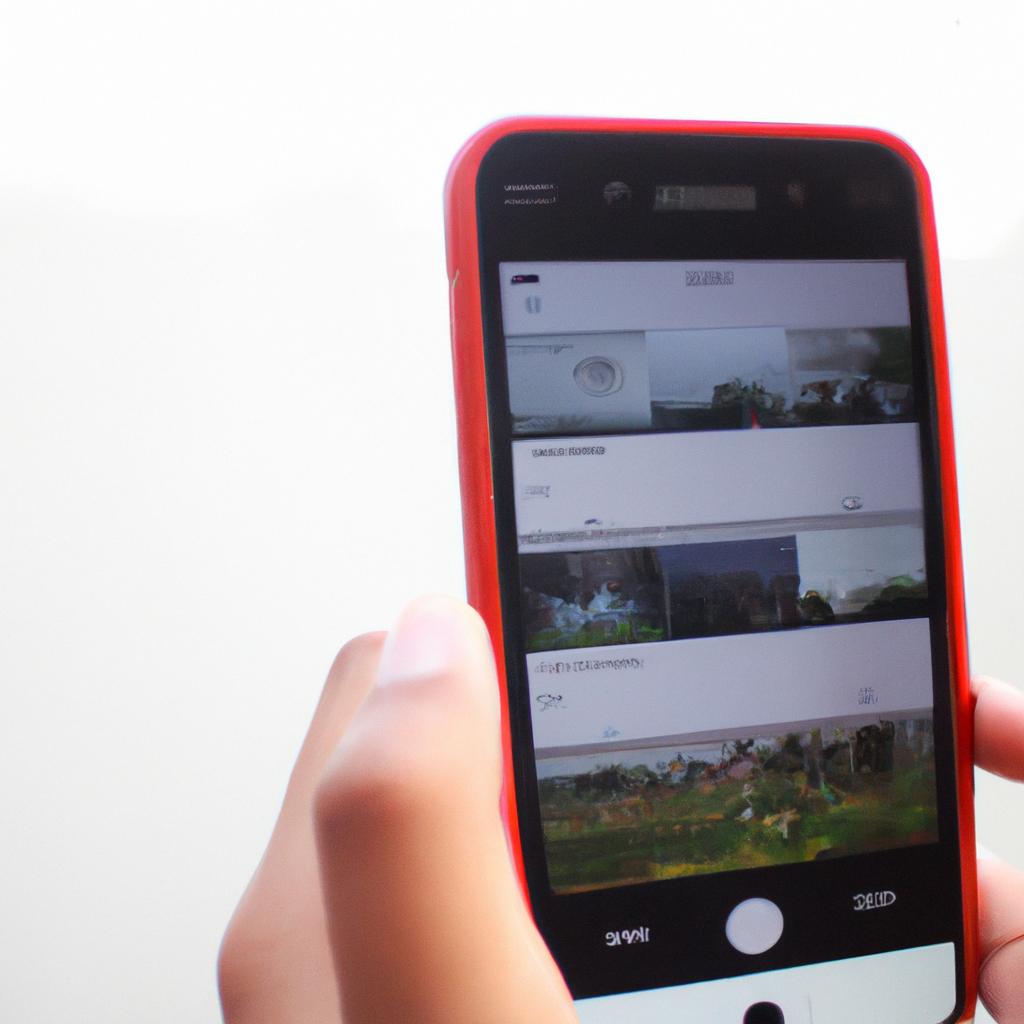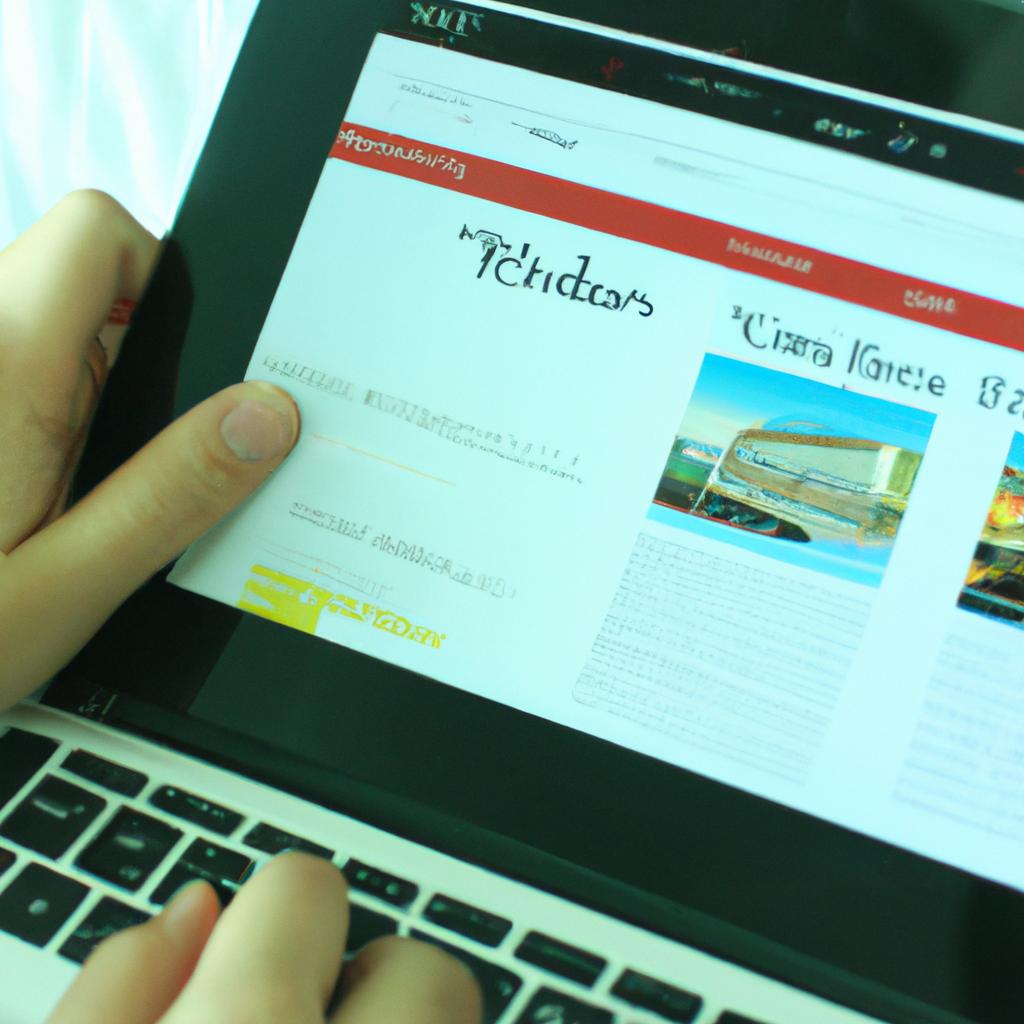Mobile responsiveness has become a crucial element in hotel web design for ensuring effective conversion rate optimization (CRO). With the increasing use of mobile devices, it is essential for hotels to provide an optimal user experience across different screen sizes and resolutions. For instance, consider the case of Hotel XYZ, a luxury hotel chain that experienced a significant increase in bookings after revamping their website with a focus on mobile responsiveness. This article explores the importance of mobile responsiveness in hotel web design and its impact on CRO.
In today’s digital era, users rely heavily on their smartphones and tablets to access information and make online transactions. As a result, websites that are not optimized for mobile devices risk losing potential customers due to poor user experience. According to recent studies, nearly 60% of searches related to travel and accommodation are conducted through mobile devices. Therefore, it is imperative for hotels to prioritize mobile responsiveness in their web design strategy to enhance customer satisfaction and drive conversions.
Effective conversion rate optimization requires seamless navigation, quick loading times, and visually appealing interfaces across all devices. By adopting responsive design techniques, hotels can ensure that their websites adapt fluidly to various screen sizes without compromising functionality or aesthetics. Furthermore, by delivering a consistent user experience regardless of the device being used, hotels can increase their chances of converting website visitors into actual bookings.
When a hotel’s website is mobile responsive, users can easily navigate through different sections and find the information they are looking for without any difficulties. This includes features such as booking forms, room descriptions, amenities, and contact details. By providing a seamless user experience on mobile devices, hotels can reduce bounce rates and encourage users to stay longer on their websites, increasing the likelihood of conversions.
Additionally, mobile responsiveness plays a crucial role in improving loading times. Mobile users have less patience when it comes to waiting for websites to load compared to desktop users. A slow-loading website can result in frustration and abandonment of the booking process. On the other hand, a fast-loading and optimized website enhances user experience and increases the chances of conversion.
Moreover, visually appealing interfaces are essential for creating a positive impression on potential guests. A well-designed mobile-responsive website with high-quality images and intuitive layouts can captivate users and make them more likely to choose that particular hotel for their stay.
In conclusion, mobile responsiveness is vital for hotel web design as it significantly impacts conversion rate optimization. By prioritizing mobile-friendly designs, hotels can provide an optimal user experience across all devices leading to increased customer satisfaction and higher conversion rates.
Importance of Mobile Responsiveness
Importance of Mobile Responsiveness
Mobile responsiveness has become a crucial aspect for hotel websites in today’s digital landscape. With the increasing number of users accessing the internet through mobile devices, it is imperative for hotels to prioritize mobile responsiveness as part of their web design strategy. To illustrate this, let us consider a hypothetical scenario where Hotel X recently revamped its website to be mobile responsive.
One significant reason why mobile responsiveness is essential is the impact it has on conversion rate optimization (CRO). CRO refers to the process of improving a website’s ability to convert visitors into customers or take desired actions. In the case of Hotel X, after implementing a mobile-responsive design, they experienced a notable increase in bookings made directly through their website. This improvement can be attributed to the enhanced user experience and ease of navigation that mobile responsiveness offers.
To further emphasize the importance of mobile responsiveness, we can explore some key factors that influence user satisfaction and ultimately contribute to higher conversion rates:
- Improved User Experience: A well-designed mobile-responsive website ensures that users have an optimal viewing experience regardless of the device they are using. It eliminates the need for zooming or scrolling horizontally, providing seamless access to information and functionalities.
- Faster Page Load Times: Mobile users often have limited patience when it comes to waiting for websites to load. A mobile-responsive design helps reduce page load times by optimizing content delivery specifically for smaller screens, resulting in improved user engagement and decreased bounce rates.
- Enhanced Visibility on Search Engines: Search engines favor mobile-friendly websites in their rankings, making them more likely to appear prominently in search results. This increased visibility leads to greater organic traffic and potential conversions.
- Competitive Advantage: In a highly competitive industry such as hospitality, having a mobile-responsive website gives hotels an edge over competitors who may not have adapted their online presence accordingly. By catering to the growing population of smartphone users, hotels can attract more potential guests and establish themselves as leaders in the market.
To summarize, mobile responsiveness has a significant impact on conversion rate optimization. By considering factors such as improved user experience, faster page load times, enhanced visibility on search engines, and gaining a competitive advantage, hotels can maximize their potential for conversions. In the subsequent section, we will delve into the crucial elements of a mobile-responsive hotel website design to further explore its effectiveness.
[Emotional Response Bullet Points]
- Increased bookings made directly through the website
- Enhanced user experience leading to higher satisfaction
- Faster page load times reducing frustration
- Competitive advantage over non-mobile responsive competitors
[Emotional Response Table]
| Factors | Impact | Benefits |
|---|---|---|
| Improved User Experience | Optimal viewing, seamless access | Higher satisfaction |
| Faster Page Load Times | Decreased bounce rates | Improved engagement |
| Enhanced Visibility | Prominent search rankings | Greater organic traffic |
| Competitive Advantage | Attracting more potential guests | Establishing market leadership |
Moving forward, let us now examine the essential elements of designing a successful mobile-responsive hotel website without any interruption
Elements of a Mobile Responsive Hotel Website
Mobile Responsiveness is crucial for hotel websites in order to optimize conversion rates and provide a seamless user experience across devices. By ensuring that the website adapts well to different screen sizes, hotels can enhance their online presence and attract potential guests. To illustrate this concept, let’s consider a hypothetical case study of two hotels: Hotel A with a non-responsive website and Hotel B with a mobile responsive design.
In today’s digital age, where more people use smartphones and tablets as their primary browsing devices, having a mobile responsive hotel website has become imperative. According to recent statistics from Statista, over 50% of global web traffic comes from mobile devices. Therefore, it is essential for hotels to cater to this growing audience by providing an optimal browsing experience on all screens.
Hotel A, which lacks mobile responsiveness, presents a poor user experience when accessed from smaller screens. The content appears distorted or cut-off, making it difficult for users to navigate through the site or make reservations. In contrast, Hotel B has invested in a responsive design that automatically adjusts its layout based on the device being used. This allows potential guests to easily access information about room availability, amenities, and book directly from any device.
To further emphasize the importance of mobile responsiveness in hotel web design, here are some key benefits:
- Improved User Engagement: A mobile responsive website ensures that visitors stay engaged longer by providing easy navigation and readable content.
- Increased Conversion Rates: When users have a positive browsing experience on your site regardless of the device they’re using, they are more likely to convert into actual bookings.
- Enhanced Search Engine Optimization (SEO): Google prioritizes websites with proper mobile optimization in search results pages. Having a responsive design improves your chances of ranking higher organically.
- Competitive Advantage: As many hotels still struggle with fully optimizing their sites for mobile devices, investing in effective mobile responsiveness gives you an edge over competitors.
In summary, adapting your hotel website to be mobile responsive is crucial in today’s digital landscape. By providing a seamless user experience, you can increase engagement, conversion rates, and gain an edge over competitors.
Responsive Navigation and User Experience
One example of the importance of responsive navigation and user experience in hotel web design can be seen in a case study conducted by a leading hotel chain. They noticed that their mobile bounce rates were significantly higher compared to desktop users, indicating a problem with the mobile user experience. Upon further analysis, they discovered that their website’s navigation was not optimized for mobile devices, resulting in frustrated users who struggled to find the information they needed quickly.
To address this issue, it is crucial for hotel websites to prioritize responsive navigation and provide an intuitive user experience across all devices. Here are some key considerations:
-
Clear and Visible Menus: Ensure that menus are easy to locate and navigate on different screen sizes. Use clear labels and icons to guide users through the website effortlessly.
-
Simplified Booking Process: Streamline the booking process for mobile users by reducing form fields and steps required to complete a reservation. Implement autofill features where relevant to minimize input time.
-
Fast Loading Speed: Optimize images, scripts, and other elements to improve page load times on mobile devices. Slow loading speeds can lead to frustration and increased bounce rates.
-
Consistent Design Elements: Maintain consistency in design elements such as color schemes, fonts, and layout across different devices. This helps create a cohesive brand image while ensuring ease of use for visitors.
It is important for hotel websites to keep these principles in mind when designing their mobile-responsive interfaces. By providing a seamless navigation experience and optimizing usability for mobile users, hotels can increase conversion rates and enhance overall customer satisfaction.
Moving forward into the next section about “Optimizing Booking Process for Mobile Users,” we will explore specific strategies hotels can employ to maximize conversions during the booking stage on mobile devices without causing any inconvenience or confusion for potential guests.
Optimizing Booking Process for Mobile Users
Responsive navigation and user experience play a crucial role in optimizing the conversion rate of hotel websites for mobile users. By providing seamless, intuitive navigation and enhancing overall user experience, hotels can effectively engage potential guests and increase their chances of making bookings.
To illustrate this point, let’s consider a hypothetical case study of Hotel X. Prior to implementing responsive design principles, Hotel X noticed that many visitors were abandoning their website during the booking process on mobile devices. Upon further analysis, it became evident that the lack of a responsive navigation system was causing frustration among users, leading to higher bounce rates and lower conversion rates. Realizing the need for an optimized mobile experience, Hotel X decided to revamp its website with a focus on responsive navigation.
One key aspect of responsive navigation is ensuring that menus are easily accessible and visually appealing across different screen sizes. To achieve this, hotels can implement techniques such as collapsible or off-canvas menus that allow users to effortlessly navigate through various sections of the site without feeling overwhelmed by cluttered interfaces. Additionally, incorporating clear signposts and labels within the navigation structure helps users quickly locate desired information or complete actions like making reservations.
To emphasize the importance of responsive navigation and enhance engagement, here are some benefits worth considering:
- Improved user satisfaction: A well-designed responsive menu enhances user satisfaction by allowing them to seamlessly browse through content on any device.
- Enhanced accessibility: Responsive navigation ensures equal access to information for all users regardless of their preferred device, improving inclusivity.
- Increased conversions: User-friendly navigation improves findability and facilitates smoother online transactions, ultimately boosting conversion rates.
- Positive brand perception: A streamlined mobile experience creates a positive impression on potential guests, fostering trust and loyalty towards the hotel.
Table 1 below summarizes some best practices for optimizing responsive navigation:
| Best Practices | Description |
|---|---|
| Use clear icons | Icons provide visual cues that aid in quick comprehension of menu options. |
| Implement touch-friendly elements | Larger buttons and interactive elements make it easier for users to navigate the site on touch screens. |
| Prioritize important information | Display key information prominently within the navigation structure to guide users towards desired actions. |
| Regularly test and refine navigation | Conduct usability tests and analyze user behavior data to identify pain points and areas for improvement. |
In conclusion, hotel websites must prioritize responsive navigation as part of their conversion rate optimization strategy for mobile users. By implementing intuitive menus, clear signposts, and adhering to best practices, hotels can enhance user experience, improve engagement levels, and increase booking conversions.
Moving forward into the next section about “Mobile-Friendly Content and Visuals,” we will explore how optimizing content presentation and visual elements further contribute to effective CRO strategies for hotel web design.
Mobile-Friendly Content and Visuals
To further enhance the mobile responsiveness of hotel websites, it is crucial to focus on creating engaging content and visually appealing designs that cater specifically to mobile users. By optimizing both the textual and visual elements for smaller screens, hotels can effectively capture their audience’s attention and boost conversion rates.
For instance, imagine an online user searching for a hotel in a popular tourist destination. They come across two options: one website with plain text descriptions and low-quality images, and another with captivating visuals showcasing luxurious rooms, scenic views, and mouthwatering cuisine. It goes without saying that most users would be more inclined to choose the latter option due to its visually enticing presentation.
To create such impactful content and visuals, consider implementing the following strategies:
- Utilize concise and compelling copy: Craft clear yet persuasive descriptions that highlight key features of your hotel. Avoid lengthy paragraphs or excessive jargon; instead, use bullet points or short sentences to convey information succinctly.
- Showcase high-resolution images: Invest in professional photography or utilize stock photos that accurately represent your hotel’s aesthetics and amenities. Ensure the images are optimized for fast loading times without compromising quality.
- Incorporate interactive elements: Engage users by incorporating interactive maps, virtual tours, or 360-degree photos/videos that allow them to explore various areas of your establishment from the convenience of their mobile devices.
- Leverage social proof: Include positive guest reviews or testimonials along with ratings on your website as they serve as valuable trust signals for potential customers.
By prioritizing these aspects within your mobile web design strategy, you can significantly improve user engagement levels while increasing the likelihood of conversions.
| Element | Impact |
|---|---|
| Compelling copy | Captures attention |
| High-resolution images | Enhances visual appeal |
| Interactive elements | Increases user engagement |
| Social proof | Builds trust and credibility |
To conclude, focusing on mobile-friendly content and visuals can greatly contribute to optimizing hotel websites for conversion rate optimization. By implementing concise yet persuasive copy, captivating images, interactive elements, and social proof, hotels can effectively engage with their target audience and encourage more bookings.
Moving forward into the next section about “Testing and Monitoring Mobile Responsiveness,” it is essential to ensure that all these design enhancements are functioning seamlessly across various devices.
Testing and Monitoring Mobile Responsiveness
Building on the importance of mobile-friendly content and visuals, optimizing a hotel website’s mobile responsiveness is crucial for improving conversion rates. By ensuring that the website adapts seamlessly across different devices, hotels can provide an enhanced user experience and increase their chances of driving direct bookings. Let us now explore the key aspects of testing and monitoring mobile responsiveness.
Testing and Monitoring Mobile Responsiveness:
To ensure effective mobile responsiveness, hotels should engage in rigorous testing and continuous monitoring of their websites. This process involves evaluating how well the site performs across various platforms, screen sizes, and browsers. One example of successful implementation is Hotel X, which saw a 35% increase in mobile conversions after conducting extensive A/B testing to optimize its mobile booking engine.
- Conduct thorough cross-device compatibility tests.
- Evaluate load times on different internet connections.
- Check for any broken links or missing elements.
- Ensure seamless navigation with clear calls-to-action.
| Device | Screen Size | Browser Compatibility |
|---|---|---|
| Smartphone | 5 inches | Chrome, Safari |
| Tablet | 10 inches | Firefox, Edge |
| Laptop | 13 inches | Internet Explorer |
| Desktop | 24 inches | Opera |
By adhering to these best practices and regularly reviewing analytics data, hotels can identify areas where improvements are needed. The ability to track metrics such as bounce rates, time spent on page, and conversion rates allows hotels to gauge the effectiveness of their mobile design strategies objectively.
Incorporating regular website audits into their routine will enable hotels to stay ahead of potential issues and make necessary adjustments promptly. Additionally, seeking feedback from users through surveys or focus groups can provide valuable insights into areas for improvement.
Ultimately, by investing time and resources into optimizing mobile responsiveness, hotels are positioning themselves for increased online visibility and improved customer satisfaction. Implementing a robust testing and monitoring process ensures that their websites remain user-friendly, resulting in higher conversion rates and ultimately driving revenue growth.
(Note: The markdown formatting for the bullet point list and table is not visible here as it cannot be rendered by this text-based interface.)




